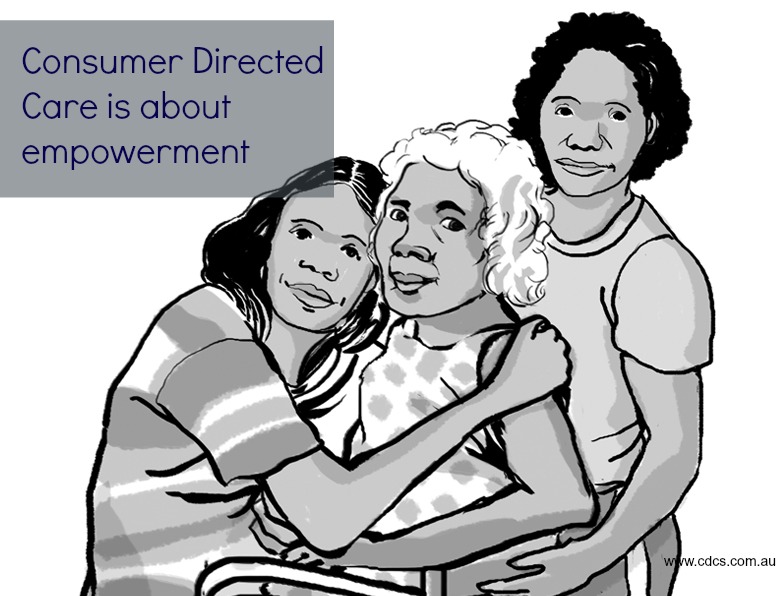So the client, or ‘consumer’ as they are now called, finally gets to have some substantial input on the care they receive. This is a great step forward. No longer does the client have to accept what an organisation or assessor believes is ‘good’ or right for them.

Consumer Directed Care, empowering clients and their family carers
The removal of the need to passively accept whatever is offered is more empowering to an individual and their family care-givers. It helps people focus on how care support can improve their lives.
How does it work? Well, we are all individuals with varied life experiences, expectations, likes and dislikes. What I think is important may not be important to you, and the way I like things done probably isn’t how you like things done. Take showering for example. I’m an evening shower person – that habit came from years of working in hot, dusty environments; if I didn’t clean up at the end of the day, I would have been banished from the house. I’m guessing that when I am older and perhaps in need of personal care support, I will still want to have my shower in the evening. However, in the past, many aged care organisations have been unable, or unwilling, to provide personal care in the evening as it is more difficult to find staff willing to work those hours. But what if I found an agency worker who was both able and willing to assist me after hours? Under the Home Care Packages Program, I could ask the organisation holding my package to engage the agency worker on my behalf to provide my personal care. This might end up being more expensive than using one of the care workers from the organisation and use up more of my budget, but it’s my package and I now get more say in how it is utilised. I am a consumer with rights!

Pet care might be a service that you need to think about providing to clients on community where there is an identified support need.
Okay, that’s a mainstream example. You’re probably saying “Carrie that won’t work out here in the bush, we don’t have that sort of choice.” So how might Consumer Directed Care be used in a remote setting? Perhaps it is in the assessment for, and coordination of, a broader range of services that you will see the differences.
Take pet care as an example. For many older aboriginal people, their dogs are very important to them. In the past, remote aged care programs have not generally assisted their clients to care for their pets. If, when conducting assessment and care planning, you find that looking after their dogs is important to the client’s emotional or physical well-being, perhaps the service can work with them to provide help with pet care. The client might pay for the dog food through their pension or Centrepay deduction and the aged care staff could ensure the animals get a meal each day and liaise with the vet when they visit the community.
Another example is meals. I have spoken to some clients who have expressed a desire to have the meals that are prepared at the local store rather than those from the aged care centre. In the past people had a take it or leave it option over delivered meals – you either ate the meals prepared by the aged care program or you went to the store and purchased your own meal. In the future, consumers may be requesting the aged care service to deliver meals prepared by the store.
Consumer Directed Care is all about providing a way for your clients to take back some degree of control over their lives. In mainstream services, it might mean they don’t have to accept an enforced change in their care worker every few months if they don’t want it; they can use their preferred cleaning lady if they have one; if they want Lean Cuisine or something similar delivered instead of Meals on Wheels, that can be accommodated. In a remote setting, CDC may mean aged care services looking at a broader range of options in meeting an individuals goals and needs in a more holistic fashion, not a one-size-fits-all. Of course, Home Care Package clients will be getting regular feedback on how their package funds are spent. As we move towards the introduction of the Commonwealth Home Support Program (CHSP) in July this year, we will need to look at transitioning all our clients across to a CDC model of care support.
Over the next few months, we know that remote services are seeking answers to questions around introducing Consumer Directed Care, including individualised budgets, the Commonwealth Home Support Program, the My Aged Care assessment gateway and the introduction of a national fees policy. It’s a challenging time for smaller and remote services, but not meeting the requirements is not impossible – we just need to think a bit more creatively.
Many of our upcoming posts will be addressing different aspects of the impending changes and are intended to help you understand and position your service to meet these challenges and provide quality care support and options for your clients within the new framework. If you are having trouble trying to understand all the changes that are about to take place, you might find it’s a good idea to sign up to our blog and follow along as we go through and explain step-by-step how remote services can more easily implement the new program. Trust us, the knowledge alone will definitely empower you and your service!
- What’s the deal with Care Coordination? - May 21, 2024
- When Cancer Gets Up Close and Personal… - May 14, 2024
- Aged Care Packages – what’s in the box? - February 16, 2024



